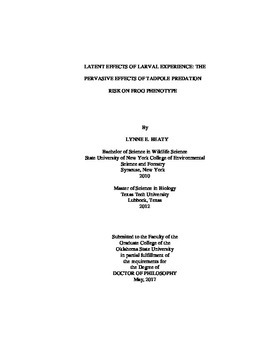| dc.description.abstract | Predation risk influences prey phenotype. Predator-induced changes in prey behavior and morphology are hypothesized to be adaptive, as long as predation risk is constant. This restriction does not hold for organisms like frogs with complex life histories, however, because each life stage experiences different predators that may require conflicting changes in phenotype. Further, metamorphosis is not necessarily a new beginning and early life experiences can continue to influence the phenotype of subsequent life stages. To better understand how tadpole predation risk influences frog phenotype throughout development, I conducted four experiments aimed at quantifying how tadpole predation risk influences 1) tadpole behavior, 2) the dynamics of metamorphosis, and 3) juvenile frog behavior and behavioral carryovers across metamorphosis, as well as 4) examining the potential to use noninvasive methods to quantify glucocorticoid stress hormones, the primary physiological response exhibited by vertebrates to predator stress, in tadpoles. For all studies, I collected naive Blanchard's cricket frog (Acris blanchardi) tadpoles from two sites around Stillwater, OK that differ in, among many factors, their history of fish predation and exposed them to cues from fish and/or dragonfly predators throughout tadpole development. After recording tadpole activity, age, size, and duration of metamorphosis, and I quantified the activity of juvenile frogs for two months after metamorphosis. To develop a non-invasive alternative to lethal whole body corticosterone (CORT) collection, I also collected waterborne CORT samples from a subset of tadpoles and compared them to tadpole whole body CORT levels and activity levels. Overall, the effects of tadpole predation risk and site of origin were pervasive -tadpole behavior, duration of metamorphosis, and juvenile phenotype were affected. In addition, I was also able to successfully assay tadpole CORT from water samples, but found CORT to not be related to tadpole activity levels. My studies are the first to show that fish can have lasting impacts on frog populations by altering frog transition during -and behavior after- metamorphosis. Furthermore, my results highlight under-studied linkages between aquatic and terrestrial ecosystems and help to develop techniques to repeatedly quantify physiological traits in small-bodied amphibians. | |
